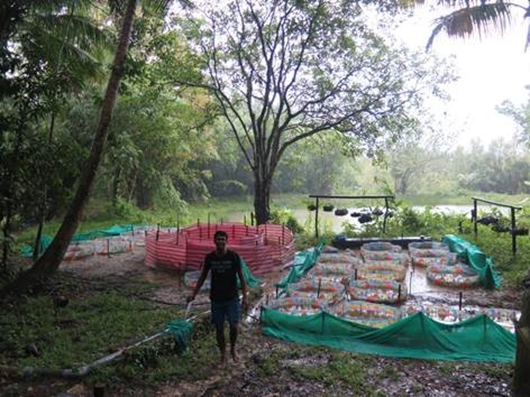2 October 2018 | By Nitya Prakash Mohanty
Public surveys can be combined with field surveys to reconstruct invasions, finds a new study by C·I·B researchers Nitya Prakash Mohanty (PhD student) and John Measey (Core Team Member).
Since it’s often too late to examine the early stages of invasions, understanding of the events leading up to rapid expansion of invasive species is usually limited. In this context, using a new approach of gathering information from the public, the researchers aimed to retrospectively understand invasion dynamics in the early stages. As a case study, they examined the Indian bullfrog’s (Hoplobatrachus tigerinus) invasion of the Andaman archipelago, Bay of Bengal. The study evaluates the use of public surveys combined with field surveys to inform invasion history variables such as: time of establishment, how the bullfrogs spread (pathways) and from where they spread (source sites).

The study found the approach to be useful as a complimentary tool in reconstructing invasions, and appropriate for other recent and moderately old invasion (up to 50 years). For example, the researchers found that the Indian bullfrog’s invasion accelerated post 2009, eight years after its initial establishment in one village in the Andaman archipelago. They further documented the influence of three ‘dispersal hubs’ for multiple transfers within the island, which could also be discerned along with dispersal pathways.
The information obtained from this approach can aid in management of future introductions of the same or similar species. Further, it can help tease apart the influence of humans on the spread of invasive species after they had been introduced to a new area.
“Humans are intrinsic to biological invasions, yet, public knowledge is seldom used to inform science”, says Nitya Prakash Mohanty, “Using a formal analytical framework, we have demonstrated the usefulness of public surveys as a tool in generating invasion history and explaining how invasive species spread”. He adds “This approach builds upon my previous work on the use of public surveys to rapidly and reliably estimate distributions of multiple invasive species.”
Read the paper at:
Mohanty, N.P. & Measey, J. (in press). Reconstructing biological invasions using public surveys: a new approach to retrospectively assess spatio-temporal changes in invasive spread. Biological Invasions DOI: 10.1007/s10530-018-1839-4
Nitya’s previous study:
Mohanty, N.P., Sachin, A., Selvaraj, G. and Vasudevan, K. 2018. Using public surveys to reliably and rapidly estimate the distributions of multiple invasive species on the Andaman archipelago. Biotropica. https://onlinelibrary.wiley.com/doi/pdf/10.1111/btp.12534
For more information, contact Nitya at nitya.mohanty@gmail.com
Media links


